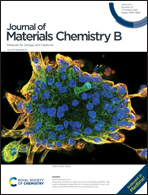An extremely tough and ionic conductive natural-polymer-based double network hydrogel†
Abstract
Hydrogels are widely used in fields such as drug delivery, tissue regeneration, soft robotics and flexible smart electronic devices, yet their application is often limited by unsatisfactory mechanical behaviors. Among the various improvement strategies, double network (DN) hydrogels from synthetic polymers demonstrated impressive mechanical properties, while those from natural polymers were usually inferior. Here, a novel DN hydrogel composed fully of natural polymers exhibiting remarkable mechanical properties and conductivity is prepared by simply soaking a virgin gellan gum/gelatin composite hydrogel in a mixed solution of Na2SO4 and (NH4)2SO4. This hydrogel exhibits a tunable Young's modulus (0.08 to 42.6 MPa), good fracture stress (0.05 to 7.5 MPa), good fracture stretch (1.4 to 7.1), high fracture toughness (up to 27.7 kJ m−2), and high ionic conductivity (up to 11.4 S m−1 at f = 1 kHz). The improvement in the mechanical properties of the DN gel is attributed to the chain-entanglement crosslinking points introduced by SO42− in the gelatin network and the electrostatic interaction crosslinking points introduced by Na+ in the gellan gum network. The high ionic conductivity of the DN gel is attributed to the infiltration of the DN gel in a salt solution of high concentration. The developed gellan gum/gelatin DN hydrogel has shown a new pathway towards strengthening natural-polymer-based DN hydrogels and towards potential applications in biomedical engineering and flexible electronic devices.



 Please wait while we load your content...
Please wait while we load your content...